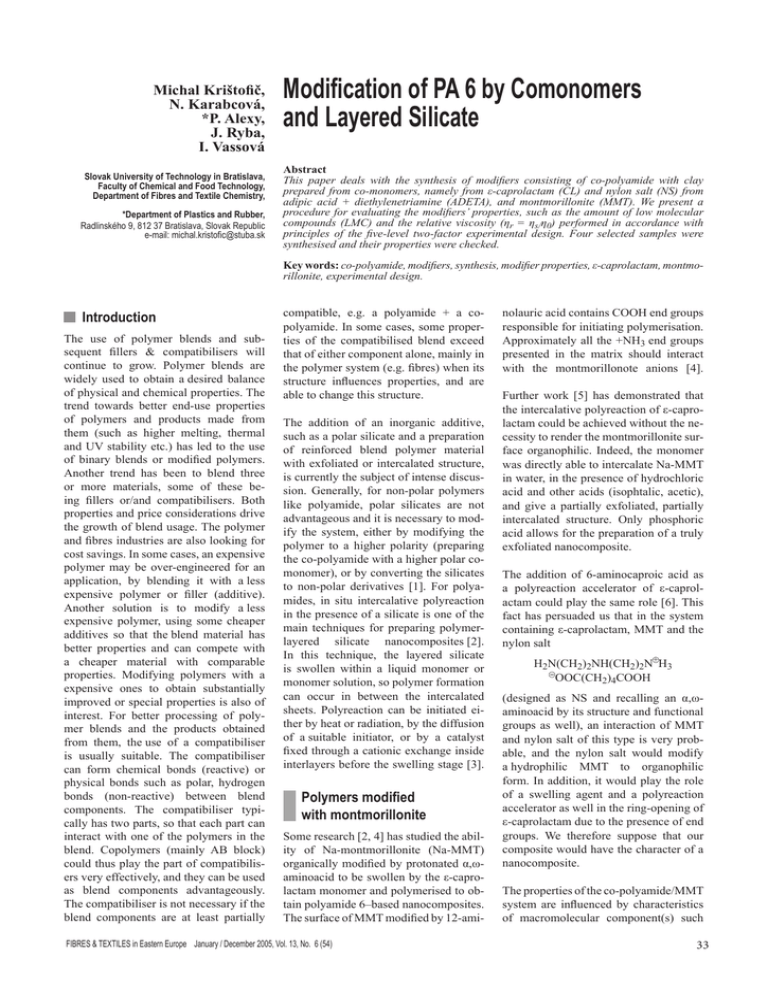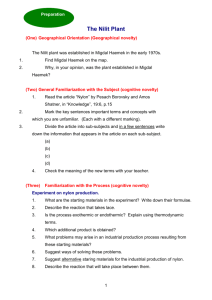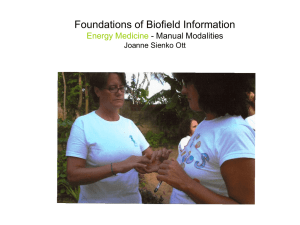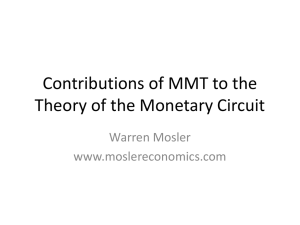Modification of PA 6 by Comonomers and Layered Silicate Michal Krištofič, N. Karabcová,
advertisement

Michal Krištofič, N. Karabcová, *P. Alexy, J. Ryba, I. Vassová Slovak University of Technology in Bratislava, Faculty of Chemical and Food Technology, Department of Fibres and Textile Chemistry, *Department of Plastics and Rubber, Radlinského 9, 812 37 Bratislava, Slovak Republic e-mail: michal.kristofic@stuba.sk Modification of PA 6 by Comonomers and Layered Silicate Abstract This paper deals with the synthesis of modifiers consisting of co-polyamide with clay prepared from co-monomers, namely from ε-caprolactam (CL) and nylon salt (NS) from adipic acid + diethylenetriamine (ADETA), and montmorillonite (MMT). We present a procedure for evaluating the modifiers’ properties, such as the amount of low molecular compounds (LMC) and the relative viscosity (ηr = ηs/η0) performed in accordance with principles of the five-level two-factor experimental design. Four selected samples were synthesised and their properties were checked. Key words: co-polyamide, modifiers, synthesis, modifier properties, ε-caprolactam, montmorillonite, experimental design. n Introduction The use of polymer blends and subsequent fillers & compatibilisers will continue to grow. Polymer blends are widely used to obtain a desired balance of physical and chemical properties. The trend towards better end-use properties of polymers and products made from them (such as higher melting, thermal and UV stability etc.) has led to the use of binary blends or modified polymers. Another trend has been to blend three or more materials, some of these being fillers or/and compatibilisers. Both properties and price considerations drive the growth of blend usage. The polymer and fibres industries are also looking for cost savings. In some cases, an expensive polymer may be over-engineered for an application, by blending it with a less expensive polymer or filler (additive). Another solution is to modify a less expensive polymer, using some cheaper additives so that the blend material has better properties and can compete with a cheaper material with comparable properties. Modifying polymers with a expensive ones to obtain substantially improved or special properties is also of interest. For better processing of polymer blends and the products obtained from them, the use of a compatibiliser is usually suitable. The compatibiliser can form chemical bonds (reactive) or physical bonds such as polar, hydrogen bonds (non-reactive) between blend components. The compatibiliser typically has two parts, so that each part can interact with one of the polymers in the blend. Copolymers (mainly AB block) could thus play the part of compatibilisers very effectively, and they can be used as blend components advantageously. The compatibiliser is not necessary if the blend components are at least partially compatible, e.g. a polyamide + a copolyamide. In some cases, some properties of the compatibilised blend exceed that of either component alone, mainly in the polymer system (e.g. fibres) when its structure influences properties, and are able to change this structure. The addition of an inorganic additive, such as a polar silicate and a preparation of reinforced blend polymer material with exfoliated or intercalated structure, is currently the subject of intense discussion. Generally, for non-polar polymers like polyamide, polar silicates are not advantageous and it is necessary to modify the system, either by modifying the polymer to a higher polarity (preparing the co-polyamide with a higher polar comonomer), or by converting the silicates to non-polar derivatives [1]. For polyamides, in situ intercalative polyreaction in the presence of a silicate is one of the main techniques for preparing polymerlayered silicate nanocomposites [2]. In this technique, the layered silicate is swollen within a liquid monomer or monomer solution, so polymer formation can occur in between the intercalated sheets. Polyreaction can be initiated either by heat or radiation, by the diffusion of a suitable initiator, or by a catalyst fixed through a cationic exchange inside interlayers before the swelling stage [3]. n Polymers modified with montmorillonite Some research [2, 4] has studied the ability of Na-montmorillonite (Na-MMT) organically modified by protonated α,ωaminoacid to be swollen by the ε-caprolactam monomer and polymerised to obtain polyamide 6–based nanocomposites. The surface of MMT modified by 12-ami- FIBRES & TEXTILES in Eastern Europe January / December 2005, Vol. 13, No. 6 (54) nolauric acid contains COOH end groups responsible for initiating polymerisation. Approximately all the +NH3 end groups presented in the matrix should interact with the montmorillonote anions [4]. Further work [5] has demonstrated that the intercalative polyreaction of ε-caprolactam could be achieved without the necessity to render the montmorillonite surface organophilic. Indeed, the monomer was directly able to intercalate Na-MMT in water, in the presence of hydrochloric acid and other acids (isophtalic, acetic), and give a partially exfoliated, partially intercalated structure. Only phosphoric acid allows for the preparation of a truly exfoliated nanocomposite. The addition of 6-aminocaproic acid as a polyreaction accelerator of ε-caprolactam could play the same role [6]. This fact has persuaded us that in the system containing ε-caprolactam, MMT and the nylon salt H2N(CH2)2NH(CH2)2N+H3 OOC(CH2)4COOH (designed as NS and recalling an α,ωaminoacid by its structure and functional groups as well), an interaction of MMT and nylon salt of this type is very probable, and the nylon salt would modify a hydrophilic MMT to organophilic form. In addition, it would play the role of a swelling agent and a polyreaction accelerator as well in the ring-opening of ε-caprolactam due to the presence of end groups. We therefore suppose that our composite would have the character of a nanocomposite. The properties of the co-polyamide/MMT system are influenced by characteristics of macromolecular component(s) such 33 Figure 1. Poly(addition-condensation) reaction of ε-caprolactam - CL and nylon salt - NS in presence of chosen silicate. as molecular weight, chemical composition, regularity of the macromolecular chain, content of co-monomer or other functional groups or atoms, and also the amount of MMT [7]. If an organophilic silicate is used, its affinity towards polymeric components will be enhanced. The chosen parameters can be evaluated by multilevel experimental design as an experimental statistical method. Both the description of the synthesis and the optimisation of the properties were solved by a chosen five-level two-factor experiment, in which individual factors ranged within levels. To evaluate the co-polyamide/MMT system, a series of co-polyamides based on ε-caprolactam and nylon salt H2N(CH2)2NH(CH2)2N H3 OOC(CH2)4COOH with MMT were prepared, and three parameters – low molecular compound content (LMC), molecular weight expressed by the relative viscosity of copolyamide solution, and polymerisation time – were evaluated by the methods of analysis of variance and by complete regression analysis [8]. n Experimental Materials used: n ε-caprolactam – CL; n adipic acid + diethylenetriamine in the form of nylon salt designed as NS; n montmorillonite Bentonite 11958 (organophilic form) – MMT; n sulphuric acid. The modifiers were prepared as follows: a) preparation of nylon salt NS (from diethylenetriamine and adipic acid); b) choice of a suitable layered silicate (organophilic montmorillonite – MMT); c) poly(addition-condensation) reaction of ε-caprolactam - CL and nylon salt - NS in the presence of the chosen silicate. This reaction is presented in Figure 1. Nylon salt (NS) was prepared by mixing an ethanolic hot solution of diethylenetriamine with an ethanolic hot solution of adipic acid. After removing the maximum amount of ethanol, a viscous solution crystallised for several days. The crystallised nylon salt was pulverised and dried in the vacuum oven. n Assessing the optimum modifier composition According to the conditions for the fivelevel two-factor experimental design presented in Table 1, 13 samples of co-polyamides composed of component show in Table 2, were synthesised each time, and then their at a temperature of T = 260 oC: n amount of low-molecular compounds (LMC) extractible in hot water, and Table 1. Experimental design conditions – recalculation of factors from coded levels to real values. -1,414 -1 0 1 1,414 Ii x1 = CL/NS factor/coded level 2,23 4,600 10,31 16,03 18,40 5,72 x2 = MMT/(NS+CL) 0,01 0,016 0,03 0,05 0,05 0,02 xi = xi,RO + xi,C Ii where: xi,R is real value for factor xi at coded value xi,RO is real value for factor xi at coded value = 0 xi,C is coded value for factor xi Ii is real value of step for factor xi 34 n the relative viscosity of the extracted modifier (ηr = ηs/η0) was determined. The concentration of NS was 5-30 wt. %, whereas the concentration of MMT was 1-5 wt. %. The experimental design served to assign the optimum composition of the system regarding the following aspects: n the maximum relative viscosity ηr , n the polyreaction time for reaching the maximum relative viscosity ηr, and n the minimum of LMC and polyreaction time for attaining the minimum of LMC. The evaluation was made by the regression analysis of the mathematical model presented below: Y = b0 + b1x1 + b2x2 + b11x12 + (1) + b22 x22 + b12x1x2 where: n factor Y represents the observed property (ηr or LMC), n factor x1 = CL/NS represents the effect of nylon salt NS as a modifier, n factor x2 = MMT/ NS + CL – represents the effect of MMT, and n b0, b1, b2, b12, b11, b22 are the regression coefficients listed in Table 3. The Statis program was used to calculate all the statistical parameters. Time dependence is not included in the experimental design, but it was studied for all samples synthesised at the following times: 30, 60, 120, 210 and 300 min. n Discussion of the results obtained From the point of view of polymer characteristics, the relative viscosity (as a value corresponding with molecular weight) is important. For many samples, ηr reaches values within the range of 1.4 FIBRES & TEXTILES in Eastern Europe January / December 2005, Vol. 13, No. 6 (54) Table 2. Composition of modifiers for experimental design. Sample No. COMPONENT CL, wt. % NS, wt. % MMT, wt. % 1 80,82 17,58 1,60 2 92,62 5,78 1,60 3 78,49 17,07 4,44 4 89,95 5,61 4,44 5 66,96 30,00 3,04 6 91,96 5,00 3,04 7 90,25 8,75 1,00 8 86,60 8,40 5,00 9 88,39 8,57 3,04 10 88,39 8,57 3,04 11 88,39 8,57 3,04 12 88,39 8,57 3,04 13 88,39 8,57 3,04 by polyreaction time exceeding 200 min. The concentration of MMT (x2 factor) has no influence on the value ηr. The value of LMC is essentially not influenced by any of the factors x1 and x2. Only the time of polyreaction is important. The LMC decreases with the increase in polyreaction time, and up to 210 min it gains almost constant values of 8 to 10 wt. %, similar to that for non–modified polyamide 6. n Synthesis of checked samples to 1.6, and the calculated maximum for ηr = 1.54 ± 0.12 is reached at the optimal polyreaction time t = 227 min. The optimal concentration of NS is 6.46 wt. %, but from the point of PA 6 modification a higher amount is more interesting. Evaluating the significance of all regression coefficients has showed that the time for reaching the maximum ηr depends on both factors x1 and x2, i.e. on the concentrations of both NS and MMT. However, the absolute value of ηr depends only on x1, and moreover only coefficients b1 and b11 are statistically significant. Relative viscosity, therefore, is mainly influenced by the x1 factor (concentration of NS) in linear and quadratic contributions, and As a consequence of the experimental design described above, a synthesis of modifiers with chosen composition (shown in Table 4) was suggested, and samples were synthesised to verify the results we obtained. A drop of ηr after the optimal polymerisation time was noted. We also observed that the higher the concentration of nylon salt (NS) is, the greater is the fall of the modifier’s relative viscosity (ηr) as a consequence of degradation reactions due to the higher amount of polycondensation water at a higher concentration of nylon salt. n Conclusions n Only the concentration of nylon salt (NS) is decisive for the relative vis- Table 3. Regression coefficients of model (1): A - coefficients for the equation when minimum of LMC is reached, B - coefficients for the equation when optimal polyreaction time is reached, C - coefficients for the equation when maximum of relative viscosity is reached, D - coefficients for the equation when polyreaction time gives maximum of relative viscosity. LMC [wt.%] Parameter η/ηο A B C D minimum time, min maximum time [min] b0 8.70 246 1.520 227 b1 -0.73 26.52 0.046 33.79 b2 -0.32 0 0.014 36.28 b11 0.994 -46.13 -0.0257 -37.15 b12 0.675 0 -0.0075 -8.86 b22 0.394 -8.62 0.0002 10.9391 sE +/- 1.10 49 0.020 1.10 sLF +/- 1.37 53 0.100 1.40 Table 4. Some properties of 4 chosen synthesized additives. CL, wt. % NS, wt. % MMT, wt. % Tm, °C ηr, LMC, wt. % 91.96 5 3.04 210 1.59 8.6 90.5 6.46 3.04 208 1.49 8.2 78.89 17.07 3.04 195 1.42 8.1 66.96 30.0 3.04 175 1.54 8.7 FIBRES & TEXTILES in Eastern Europe January / December 2005, Vol. 13, No. 6 (54) cosity of the additive. The concentration of MMT is not important. n The amount of low molecular com- pounds is comparable with that for non-modified PA 6, and decreases with polyreaction time. n The melting point Tm falls proportion- ally with the amount of nylon salt (NS). n The relative viscosity (ηr ) of the syn- thesised additives increases with the polyreaction time until the optimum point (227 min), and after that it falls. The higher the concentration of nylon salt (NS) is, the greater is the fall of the ηr value. n From the point of view of relative viscosity, the optimal amount of NS is 6.46 wt. %. n The properties of the 4 selected addi- tive composites have verified the results obtained from the experimental design. Acknowledgment The support of the National Grant Agency of Slovakia APVT - Grant No 20-010102 and VEGA 1/2475/05 is appreciated. References 1. Vaia, R.A., Ishii, H., Giannelis, E.P.: Chem. Mater., 1993, 5, 1694. 2. Usuki A., Kojima Y., Kawasumi M., Okada A., Fukushima Y., Karauchi T., Kamigaito, O.: J. Mater. Res. 1993, 8, 1179. 3. Alexander, M., Dubois, P.: Mater. Science and Engineering, 2000, 28, 7. 4. Usuki A., Kawasumi M., Kojima Y., Okada A., Karauchi T., Kamigaito O.: J. Mater. Res. 1993, 8, 1174. 5. Kojima, Y., Usuki M., Kawasumi A., Okada A., Karauchi T., Kamigaito O.: J. Polymer. Chem. 1993,31, 983. 6. Kojima Y., Usuki M., Kawasumi A., Okada A., Karauchi T., Kamigaito O.: J. Polym. Sci. Part A: Polymer Chem. 1993, 31, 1755. 7. Encyclopedia of Polymer Sci. and Tech., Vol 10, 1969, John Willey and Sons, New York, pp. 348, 526, 530. 8. Alexy, P., Viselka, M.: Základy plánovania a vyhodnocovania experimentov (Basis of planning and plotting of experiments), skriptá STU FCHPT, Bratislava 1998. Received 07.04.2004 Reviewed 10.10.2004 35








